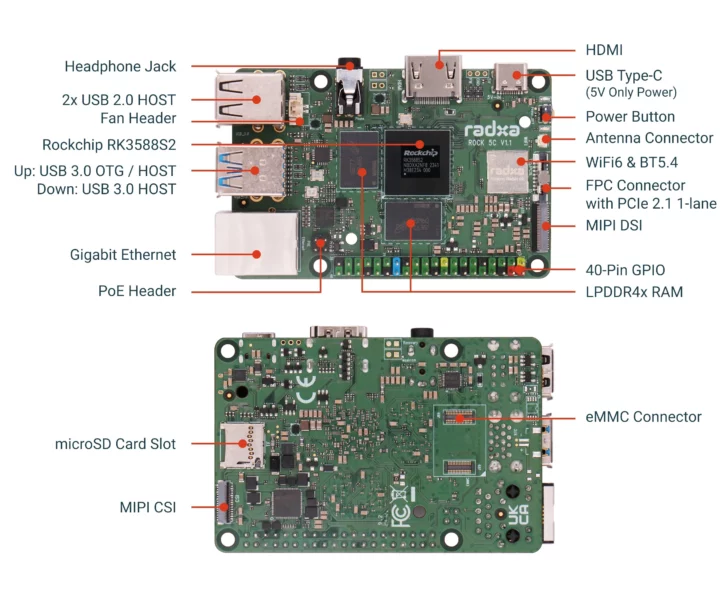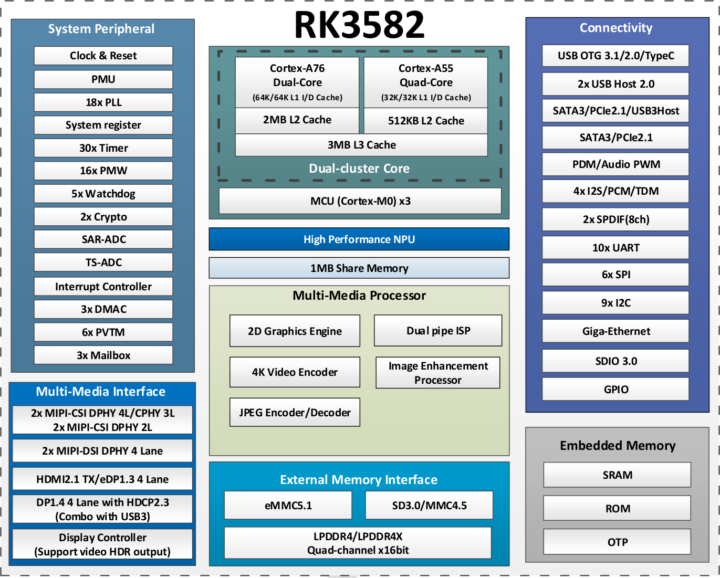Rockchip RK3582 hexa-core SoC is pin-to-pin compatible with the popular Rockchip RK3588S octa-core Cortex-A76/A55 SoC, but only features two Cortex-A76 cores, a 5 TOPS NPU (instead of 6 TOPS) and does not come with a 3D GPU.
I was first made aware of the Rockchip RK3582 in October 2023 when I was sent a photo of a board allegedly for a TV box, but while the RK3582 still features a 4K video decoder, the lack of a 3D GPU could make it problematic with 3D accelerated user interface. We now have more details with Radxa having released the datasheet and a few more interesting details.
Rockchip RK3582 specifications:
- Hexa-core CPU – 2x Cortex-A76 and 4x Cortex-A55 cores in dynamIQ configuration (frequencies are still shown as TBD in the datasheet)
- GPU
- No 3D GPU
- 2D graphics engine up to 8192×8192 source, 4096×4096 destination
- AI Accelerator – 5 TOPS NPU 3.0 (Neural Processing Unit)
- VPU
- Video decoding
- 8Kp60 H.265, VP9, AVS2, 8Kp30 H.264 AVC/MVC
- 4Kp60 AV1
- 1080p60 MPEG-2/-1, VC-1, VP8
- Real-time 4Kp60 encoding with H.265/H.264; multi-channel encoding supported at lower resolutions
- Video decoding
- Memory I/F – LPDDR4/LPDDR4x/LPDDR5 up to 32GB
- Storage – eMMC 5.1, SD/MMC, SATA 3.0 (multiplexed with PCIe 2.0), FSPI (Flexible SPI)
- Video Output
- Dual HDMI 2.1 / eDP 1.3 up to 8Kp60 (4Kp60 for eDP)
- 1x DisplayPort 1.4a up to 8Kp30 (multiplexed with USB 3.0)
- Dual MIPI DSI output up to 4Kp60
- Bt.1120 video output up to 1080p60
- Up to four independent displays (up to 1x 8Kp60, 2x 4Kp60, 1x 2048×1080 @ 60 Hz)
- Video Input/Camera
- 48MP (2x 24MP) ISP with HDR and 3D NR support; multi-camera input
- 2x MIPI DC (4-lane DPHY v2.0 or 3-lane CPHY V1.1)
- 4x 2-lane MIPI CSI
- DVP camera interface
- Audio
- 2x 8-channel I2S, 2x 2-channel I2S
- 2x SPDIF
- 2x 8-channel PDM (for mic arrays)
- 2-channel digital audio codec (16-bit DAC)
- VAD engine
- Networking – Dual Gigabit Ethernet
- USB – 1x USB 3.1 Gen 1 up to 5 Gbps (multiplexed with DisplayPort), 1x USB 3.1 Gen 1 (multiplexed with Combo “PIPE PHY2”), 2x USB 2.0 host
- 2x Combo PIPE PHY interfaces
- Combo PIPE PHY0/1 – SATA III or PCIe2.1 up to 5 Gbps
- Combo PIPE PHY2 – SATA III, PCIe 2.1, or USB 3.0
- Other I/O – 6x SPI, 9x I2C, 10x UART, GPIOs, 12-bit ADC (SARADC), SDIO 3.0, 3x CAN Bus
- Package – FCCSP1253L; 17 x 17mm
- Manufacturing process – 8nm LP
The real changes over RK3588S are the two Cortex-A76 cores, the lack of Arm Mali-G610 GPU, and the NPU being limited to 5 TOPS. Some smaller changes in the datasheet are the encoder capabilities (4Kp60 vs 8Kp30, but that is probably just a different way of saying the same thing) and the resolution for the fourth display can be up to 2048 x 1080.

We learned about the new Rockchip RK3582 as Radxa unveiled the upcoming ROCK 5C SBC powered by a Rockchip RK3588S2 (unclear how it differs from RK3588S) and the ROCK 5C Lite based on the pin-compatible RK3582. We’ll cover those two boards in more detail once they become available. But the announcement thread has some intriguing tidbits:
If you are lucky, you can unlock the RK3582 to Quad A76!
..
GPU is unknown, if you are lucky, you will have GPU, if not, then no GPU.
The way I read this is that the RK3582 is an RK3588S with defects. Rockchip must have noticed they had a non-negligible number of RK3588S that did not pass QC (quality control) due to a few Cortex-A76 cores not working, the GPU failing, or the NPU not working up to expectations, so the RK3582 was born. That’s why you may get four Cortex-A76 cores or the GPU working in some RK3582 parts, but likely not both of them, unless the chip was downgraded from being a RK3588S due to the NPU.
Thanks to Geoffrey for the tip.

Jean-Luc started CNX Software in 2010 as a part-time endeavor, before quitting his job as a software engineering manager, and starting to write daily news, and reviews full time later in 2011.
Support CNX Software! Donate via cryptocurrencies, become a Patron on Patreon, or purchase goods on Amazon or Aliexpress





